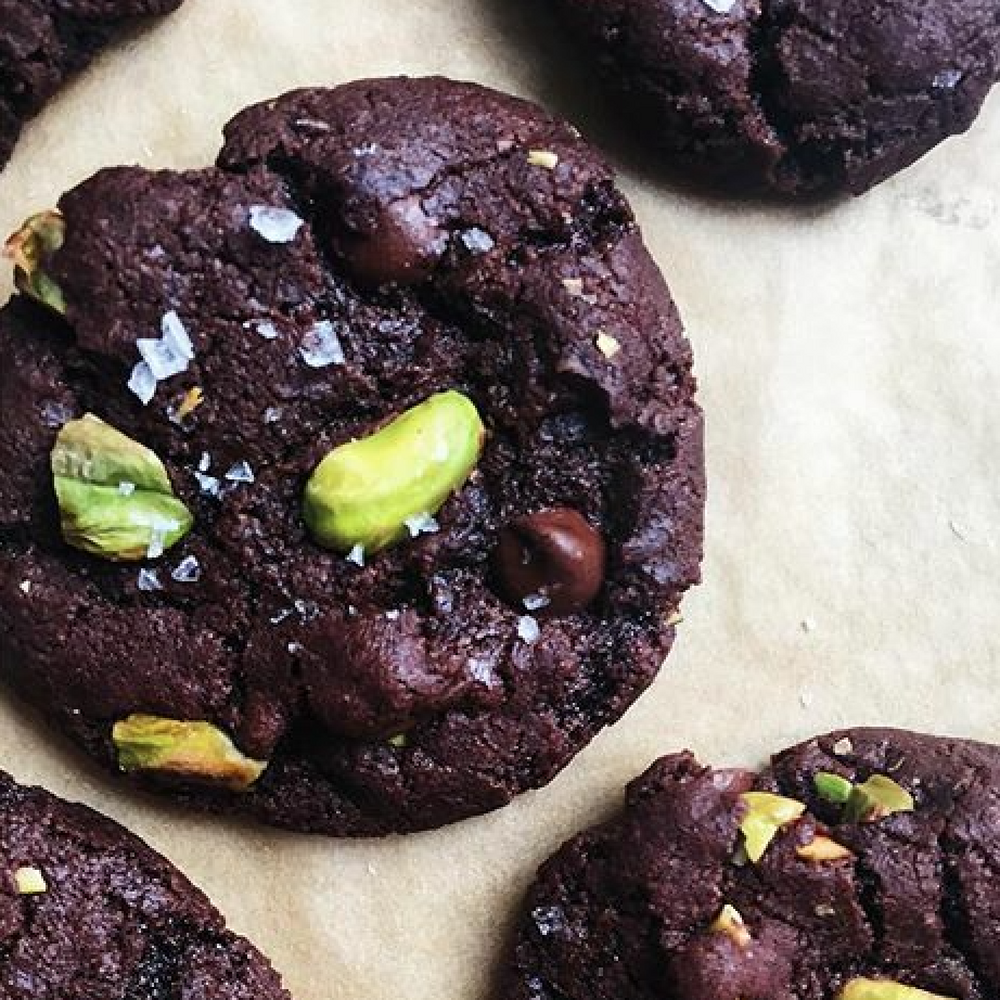"*Drumrolls please* .. Its Gudi Padwa today (marking the New year as per the Hindu calendar)..And nothing spells more festive than a thali (plate) full of traditional maharashtrian delicacies.. No adulteration of flavors, no fusion-vusion, lowfat/glutenfree, diet-viet.. just sheer home made, simple fuss-free food .. Just like grandma made! Here's to more childhood memories ..Happy Gudi Padwa everyone! ..
In clockwise direction: - Bhajyanchi amti (Fried chickpea fritters braised in a coconut gravy) ..
- Daalichi amti (sweet,sour and spicy lentil stew) ..
- Papad ..
- Sabudana kheer (sago milk pudding with saffron and cardamom) ..
- Tondlichi bhaji (stir fried ivy gourd)..
- Gajarachi koshimbir (grated carrot and peanuts salad) ..
- Chaas (buttermilk) ..
- Roti and rice"
Gudi Padwa Feast
5
- ★★
- ★★
- ★★
- ★★
- ★★

Maharashtrian Carrot Salad or Gajarachi Koshimbir
RECIPE:
Serves 2
Ingredients for salad
1. Grated carrots – 1 cup (around 2 medium sized)
2. Coarse Peanut powder - 2-3 tablespoons
3. Scraped fresh coconut – 1 tablespoon
4. Lemon juice - 1 teaspoon
5. Cilantro leaves chopped – 1 tablespoon
6. Sugar – 1 tablespoon
7. Salt to taste
For the tempering:
1. Oil or ghee – 1 tablespoon
2. Black mustard seeds – 1/4 teaspoon
3. Cumin seeds - 1/4 teaspoon
4. Asafetida – a pinch
5. Curry leaves (optional) – 2-3 leaves finely chopped
Procedure
1. Combine all the ingredients for the salad in a bowl
2. For the tempering, heat oil or ghee
3. Add the mustard seeds followed by cumin seeds, curry leaves and asafetida powder in order
4. Once the mustard and cumin seeds sputter in the oil, and there’s a fragrant smell of the tempering, take it off the flame
5. Pour the tempering over the salad mixture
6. Mix lightly and serve immediately
Maharashtrian Pakora curry in a coconut based gravy or Bhajyanchi amti
Serves 2-3
Accompaniments – Roti or Steamed rice
There are 2 elements in this dish – Pakoras (fritters) which are simmered in a coconut gravy
Ingredients for the pakoras
1. Besan (Gram flour) – ½ - 3/4 cup
2. Rice flour – 2 tablespoons
3. Red chili powder – 1 teaspoon
4. Turmeric powder – ½ teaspoon
5. Salt – to taste
6. Sugar – a pinch
7. Caraway seeds (optional) – ¼ teaspoon
8. Cilantro (Coriander leaves) finely chopped– 2 tablespoons
9. Cabbage finely chopped – 1 cup
10. Water – ⅓ cup
11. Oil – for deep frying pakoras
Ingredients for the gravy
1. Freshly scraped coconut – 1 cup
2. Turmeric powder – ½ teaspoon
3. Red chili powder – ½ to 1 tablespoon (depending on spice preference)
4. Jaggery/ sugar – 1 tablespoon
5. Tamarind pulp – ½ teaspoon
6. Cumin seeds – ½ teaspoon
7. Coriander seeds – 1 teaspoon
8. Fenugreek seeds – 3-4 number
9. Black peppercorns – 1-2 in number
10. Salt to taste
Procedure for the pakoras:
1. Combine besan and rice flour in a bowl. Also add salt, sugar, caraway seeds, red chili powder and turmeric powder.
2. Add cabbage and cilantro to this mixture
3. Slowly add the water to form a smooth lump free batter
4. Heat oil for frying
5. Check the temperature of the oil by dropping a small spoonful of batter into the oil. If it rises to the top immediately then it is too hot. If it stays at bottom then oil is not hot enough. If the batter rises to the top after 2-3 seconds the oil is ready for deep frying.
6. Drop the batter in spoonfuls in the hot oil.
7. Fry till it becomes golden brown and crispy from all the sides
8. Drain excess oil on a tissue
9. Alternately you may bake the pakoras at 375 degrees F for about 15-20 minutes till the batter inside is cooked through and not raw.
Procedure for the curry
1. Blend the ‘mixture for blender’ in a blender till very smooth. The mixture should not feel lumpy when felt in between the fingers
2. Heat a saucepan and transfer this coconut sauce in the pan
3. Add water to the mixture and adjust the consistency to that of a thai curry
4. Cover and let it simmer
5. Once simmered, drop the pakoras into the sauce
6. Keep it on the flame till the sauce simmers and the pakoras absorb the sauce slightly (about 3-4 minutes)
7. At this point, adjust the salt accordingly
8. Note – the Pakoras absorb a lot of moisture once transferred to the gravy. So adjust the consistency accordingly
Maharashtrian style Lentil stew or Daalichi Amti
Serves 2-3
Accompaniments – Roti or Steamed rice
Ingredients for the daal
1. Pigeon pea lentils/ toor daal – 1 cup soaked in water for about an hour
2. Turmeric powder – ½ teaspoon
3. Salt to taste
4. Water – 2.5 to 3 cups
For the tempering
1. Tomato finely chopped – 1
2. Asafetida – ½ teaspoon
3. Turmeric powder – ½ tablespoon
4. Jaggery or sugar – 1 tablespoon
5. Mustard seeds - 1 tablespoon
6. Curry leaves – 5-6 in number
7. Tamarind pulp – 1/4 teaspoon
8. Chopped cilantro – 2 tablespoons
9. Scraped fresh coconut (optional) – 1 tablespon
10. Green chilies chopped – 2
11. Oil or ghee – 2 tablespoons
12. Salt to taste
13. Water to adjust consistency
14. Extra chopped cilantro for garnishing
Procedure
1. Soak the lentils in some water for about an hour
2. In a pressure cooker, add the soaked lentils, turmeric, salt and about 2.5 to 3 times the water
3. Pressure cook until you hear 4 whistles. Switch it off.
4. Let the cooker cool and the steam escape
5. Once cooled, mash the cooked daal slightly using the back of a ladle. Leave aside.
6. For tempering, heat the oil.
7. Once hot, add the asafetida followed by the mustard seeds.
8. Once the mustard seeds sputter, add the rest of the ingredients – curry leaves, tomatoes, green chilies, coconut, jiggery, tamarind and cilantro
9. Saute lightly
10. Add the mashed daal to the tempering
11. Add salt to taste
12. If required add about ½ cup to 1 water to adjust the consistency to that of a stew 13. Cover and let this mixture come to a boil.
14. Garnish with cilantro and serve hot.
Sago pudding flavored with cardamom and saffron or Sabudana kheer
Serves 2-3
Ingredients
1. Sabudana or tapioca pearls - ½ cup. For a denser kheer, you can use ⅔ to ¾ cup sabudana
2. Milk – 3- 4 cups
3. Water - 1 cup
4. Sugar – 6 tablespoons sugar or as required
5. Green cardamom - 4-5 husked and crushed in a mortar-pestle to a semi fine powder OR 1 teaspoon cardamom powder
6. Chopped cashews - 2 tablespoons
7. Saffron strands - 3-4 soaked in 2 tablespoons of hot milk
Procedure
1. Wash the tapioca pearls in running water till water runs clear of the starch.
2. Soak the pearls in water for about 2-3 hours till they bloat up, are soft and double in size
3. Once the pearls ae doubled, heat a sauce pan, add the pearls along with the remnant water
4. Add 3 cups of milk, cover and cook this mixture till the pearls are translucent and chewy in texture
5. This should take about 20 minutes
6. At this point, if you see a pudding like consistency, add the sugar, cashews, saffron and cardamom powder
7. Simmer for about 2-3 minutes
8. You can serve this immediately or chill and serve
9. This pudding thickens as it cools. Therefore one can adjust it to the required consistency by adding more milk and sugar as desired.
RECIPE:
Serves 2
Ingredients for salad
1. Grated carrots – 1 cup (around 2 medium sized)
2. Coarse Peanut powder - 2-3 tablespoons
3. Scraped fresh coconut – 1 tablespoon
4. Lemon juice - 1 teaspoon
5. Cilantro leaves chopped – 1 tablespoon
6. Sugar – 1 tablespoon
7. Salt to taste
For the tempering:
1. Oil or ghee – 1 tablespoon
2. Black mustard seeds – 1/4 teaspoon
3. Cumin seeds - 1/4 teaspoon
4. Asafetida – a pinch
5. Curry leaves (optional) – 2-3 leaves finely chopped
Procedure
1. Combine all the ingredients for the salad in a bowl
2. For the tempering, heat oil or ghee
3. Add the mustard seeds followed by cumin seeds, curry leaves and asafetida powder in order
4. Once the mustard and cumin seeds sputter in the oil, and there’s a fragrant smell of the tempering, take it off the flame
5. Pour the tempering over the salad mixture
6. Mix lightly and serve immediately
Maharashtrian Pakora curry in a coconut based gravy or Bhajyanchi amti
Serves 2-3
Accompaniments – Roti or Steamed rice
There are 2 elements in this dish – Pakoras (fritters) which are simmered in a coconut gravy
Ingredients for the pakoras
1. Besan (Gram flour) – ½ - 3/4 cup
2. Rice flour – 2 tablespoons
3. Red chili powder – 1 teaspoon
4. Turmeric powder – ½ teaspoon
5. Salt – to taste
6. Sugar – a pinch
7. Caraway seeds (optional) – ¼ teaspoon
8. Cilantro (Coriander leaves) finely chopped– 2 tablespoons
9. Cabbage finely chopped – 1 cup
10. Water – ⅓ cup
11. Oil – for deep frying pakoras
Ingredients for the gravy
1. Freshly scraped coconut – 1 cup
2. Turmeric powder – ½ teaspoon
3. Red chili powder – ½ to 1 tablespoon (depending on spice preference)
4. Jaggery/ sugar – 1 tablespoon
5. Tamarind pulp – ½ teaspoon
6. Cumin seeds – ½ teaspoon
7. Coriander seeds – 1 teaspoon
8. Fenugreek seeds – 3-4 number
9. Black peppercorns – 1-2 in number
10. Salt to taste
Procedure for the pakoras:
1. Combine besan and rice flour in a bowl. Also add salt, sugar, caraway seeds, red chili powder and turmeric powder.
2. Add cabbage and cilantro to this mixture
3. Slowly add the water to form a smooth lump free batter
4. Heat oil for frying
5. Check the temperature of the oil by dropping a small spoonful of batter into the oil. If it rises to the top immediately then it is too hot. If it stays at bottom then oil is not hot enough. If the batter rises to the top after 2-3 seconds the oil is ready for deep frying.
6. Drop the batter in spoonfuls in the hot oil.
7. Fry till it becomes golden brown and crispy from all the sides
8. Drain excess oil on a tissue
9. Alternately you may bake the pakoras at 375 degrees F for about 15-20 minutes till the batter inside is cooked through and not raw.
Procedure for the curry
1. Blend the ‘mixture for blender’ in a blender till very smooth. The mixture should not feel lumpy when felt in between the fingers
2. Heat a saucepan and transfer this coconut sauce in the pan
3. Add water to the mixture and adjust the consistency to that of a thai curry
4. Cover and let it simmer
5. Once simmered, drop the pakoras into the sauce
6. Keep it on the flame till the sauce simmers and the pakoras absorb the sauce slightly (about 3-4 minutes)
7. At this point, adjust the salt accordingly
8. Note – the Pakoras absorb a lot of moisture once transferred to the gravy. So adjust the consistency accordingly
Maharashtrian style Lentil stew or Daalichi Amti
Serves 2-3
Accompaniments – Roti or Steamed rice
Ingredients for the daal
1. Pigeon pea lentils/ toor daal – 1 cup soaked in water for about an hour
2. Turmeric powder – ½ teaspoon
3. Salt to taste
4. Water – 2.5 to 3 cups
For the tempering
1. Tomato finely chopped – 1
2. Asafetida – ½ teaspoon
3. Turmeric powder – ½ tablespoon
4. Jaggery or sugar – 1 tablespoon
5. Mustard seeds - 1 tablespoon
6. Curry leaves – 5-6 in number
7. Tamarind pulp – 1/4 teaspoon
8. Chopped cilantro – 2 tablespoons
9. Scraped fresh coconut (optional) – 1 tablespon
10. Green chilies chopped – 2
11. Oil or ghee – 2 tablespoons
12. Salt to taste
13. Water to adjust consistency
14. Extra chopped cilantro for garnishing
Procedure
1. Soak the lentils in some water for about an hour
2. In a pressure cooker, add the soaked lentils, turmeric, salt and about 2.5 to 3 times the water
3. Pressure cook until you hear 4 whistles. Switch it off.
4. Let the cooker cool and the steam escape
5. Once cooled, mash the cooked daal slightly using the back of a ladle. Leave aside.
6. For tempering, heat the oil.
7. Once hot, add the asafetida followed by the mustard seeds.
8. Once the mustard seeds sputter, add the rest of the ingredients – curry leaves, tomatoes, green chilies, coconut, jiggery, tamarind and cilantro
9. Saute lightly
10. Add the mashed daal to the tempering
11. Add salt to taste
12. If required add about ½ cup to 1 water to adjust the consistency to that of a stew 13. Cover and let this mixture come to a boil.
14. Garnish with cilantro and serve hot.
Sago pudding flavored with cardamom and saffron or Sabudana kheer
Serves 2-3
Ingredients
1. Sabudana or tapioca pearls - ½ cup. For a denser kheer, you can use ⅔ to ¾ cup sabudana
2. Milk – 3- 4 cups
3. Water - 1 cup
4. Sugar – 6 tablespoons sugar or as required
5. Green cardamom - 4-5 husked and crushed in a mortar-pestle to a semi fine powder OR 1 teaspoon cardamom powder
6. Chopped cashews - 2 tablespoons
7. Saffron strands - 3-4 soaked in 2 tablespoons of hot milk
Procedure
1. Wash the tapioca pearls in running water till water runs clear of the starch.
2. Soak the pearls in water for about 2-3 hours till they bloat up, are soft and double in size
3. Once the pearls ae doubled, heat a sauce pan, add the pearls along with the remnant water
4. Add 3 cups of milk, cover and cook this mixture till the pearls are translucent and chewy in texture
5. This should take about 20 minutes
6. At this point, if you see a pudding like consistency, add the sugar, cashews, saffron and cardamom powder
7. Simmer for about 2-3 minutes
8. You can serve this immediately or chill and serve
9. This pudding thickens as it cools. Therefore one can adjust it to the required consistency by adding more milk and sugar as desired.



